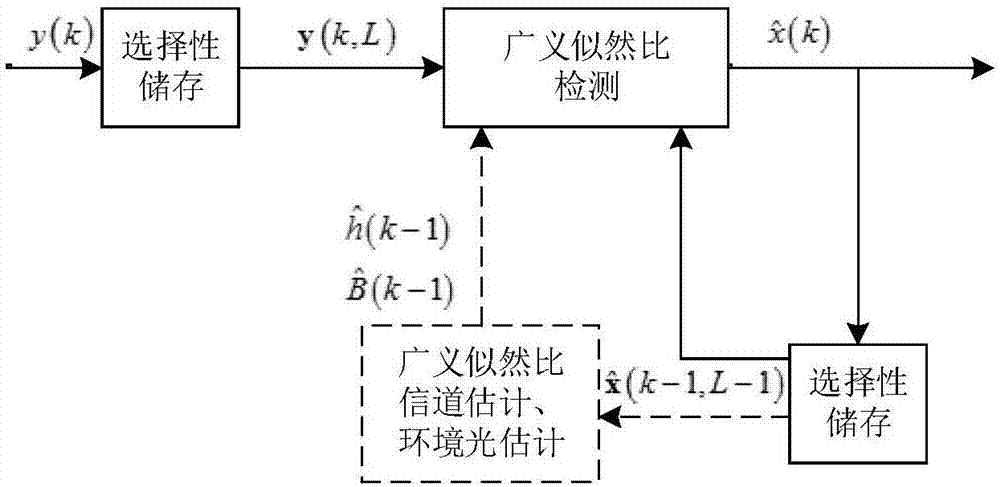Ambient light elimination symbol-by-symbol detection method requiring no channel estimation in wireless optical communication
A wireless optical communication and channel estimation technology, applied in the field of ambient light elimination symbol-by-symbol detection, can solve problems such as system complexity increase, achieve the effect of simple algorithm, reduce system complexity and storage capacity
- Summary
- Abstract
- Description
- Claims
- Application Information
AI Technical Summary
Problems solved by technology
Method used
Image
Examples
example 1
[0035] Example 1 takes a wireless optical communication OOK system as an example to provide a symbol-by-symbol detection method for ambient light cancellation without channel estimation. The method forms a sequence of a discrete electrical signal received and sampled and previous decision signals in the observation window, and uses the generalized likelihood ratio measure and decision conditions to make a decision on a single signal at the current moment, that is, to detect symbol by symbol. The method includes the following steps:
[0036] (1) Establish a channel model: Determine the observation window length as L symbol periods according to the channel correlation time and system storage capacity, and the channel and ambient light status in the observation window remain unchanged. The signal in the observation window is expressed as follows: the sending sequence is x(k,L)=[x(k-L+1),...,x(k)], and the receiving sequence is y(k,L)=[y (k-L+1),...,y(k)], the noise sequence is n...
example 2
[0043]Example 2 In the wireless optical communication quaternary IM / DD system, the value changes of h(k) and B(k) within several observation window lengths are negligible, and the rest are the same as in Example 1. Only the difference between the example 2 method and the example 1 is detailed below:
[0044] (1) Establishing a channel model: It can be assumed that h(k)=h(k-1), B(k)=B(k-1). Therefore, the receiver estimates the channel state and ambient light at time k-1 as the estimated value at time k, that is, Example 2 uses figure 1 The solid and dashed lines.
[0045] (2) The transmitter first transmits L p Pilot symbols 3 known by the receiving end, where L p <L, after which data symbols unknown to the transmitter and receiver;
[0046] (3) In the decision sequence including initial pilot symbols, the receiving end selects modulation symbols 1 / 2 / 3, discarding all modulation symbols 0, that is, L 0 = 0, generate
[0047] (4) Judgment sequence based on accumulated...
PUM
 Login to View More
Login to View More Abstract
Description
Claims
Application Information
 Login to View More
Login to View More - R&D
- Intellectual Property
- Life Sciences
- Materials
- Tech Scout
- Unparalleled Data Quality
- Higher Quality Content
- 60% Fewer Hallucinations
Browse by: Latest US Patents, China's latest patents, Technical Efficacy Thesaurus, Application Domain, Technology Topic, Popular Technical Reports.
© 2025 PatSnap. All rights reserved.Legal|Privacy policy|Modern Slavery Act Transparency Statement|Sitemap|About US| Contact US: help@patsnap.com



